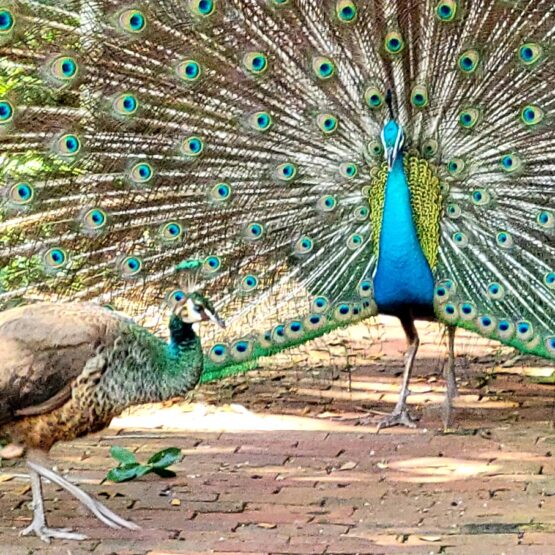A vegetable garden is not complete without flowers planted in it – scattered around in various beds among the many types of vegetables we’re growing. While flowers certainly add beauty to the garden (who doesn’t love them?!), their main purpose is to attract beneficial insects to the environment. These insects act as predators to non-beneficial insects and as pollinators for vegetable production. Flowering plants provide a place for insects to lay eggs, caterpillars to thrive, and adult insects to feed. Insects are such a vital part of the growing cycle, and help to protect the health of plants, that we take them for granted, or sometimes may even wish we didn’t have them (unless they’re pretty)! As an aside, here is an interesting “factoid” for you: What percentage of insects are harmful? You won’t believe, me; feel free to look it up – One percent. Yes: 1, uno. Look it up.
On our Resources page, you will find several article/sites with information on beneficial insects and the flowers that attract them. Most (but not all) of these flowers are suitable to South Florida, given our unique growing environment.
This past year, we have amped up the variety of flowers we are growing, and hope to add even more to the mix in the coming season. It is so easy to grow flowers; plant the seeds, water, and enjoy – little to no maintenance required. We’ve even begun to pick them for flower arrangements when we have our seasonal events. Unless otherwise noted, these have all acted as annuals in our garden, meaning they need to be replanted each year. We start almost all of them (except for sunflowers) in starter trays and then transplant the seedlings into the garden beds. Here are some of the flowers we’ve grown and enjoyed:
Sunflowers
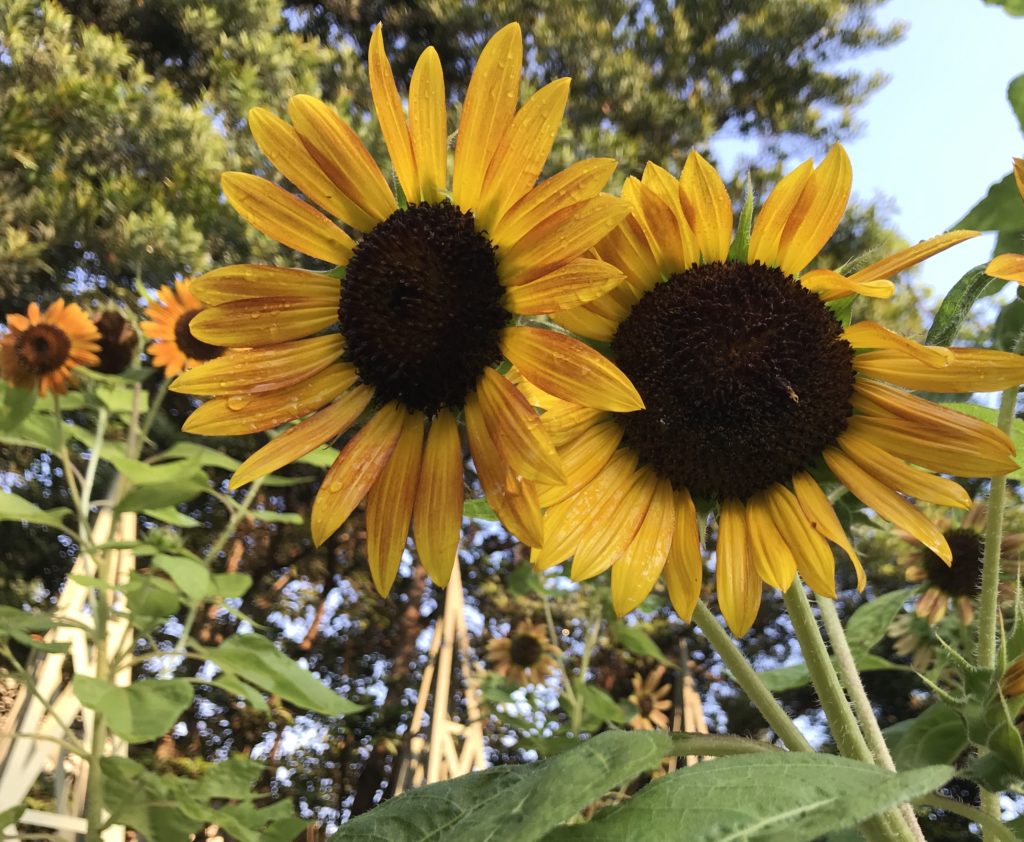
Sisters!

Oh, happy day!
The sunflowers are our late season addition to the garden. We typically plant them in May as they thrive in the warm weather, so now we are enjoying these summer bloomers. Not surprisingly, they require lots of sun!
We do plant the seeds directly into the beds. Some years are better than others for us in terms of germination, which might partly depend on our lack of attention when we are purchasing seeds to what varieties grow better in South Florida. Please check out this valuable information on Florida-friendly varieties of sunflowers, including when and where to plant them: UF/IFAS Gardening Solutions: Sunflowers This info will help us choose varieties for better production in the future, such as the pretty light yellow “Valentine” variety which we’plan to try next year.
The variety that’s doing well in the garden right now (as pictured) comes from Seed Savers Exchange, and is called “Evening Sun Sunflower” – it includes different colored flowers in the one seed packet.
Zinnias

Orange zinnia
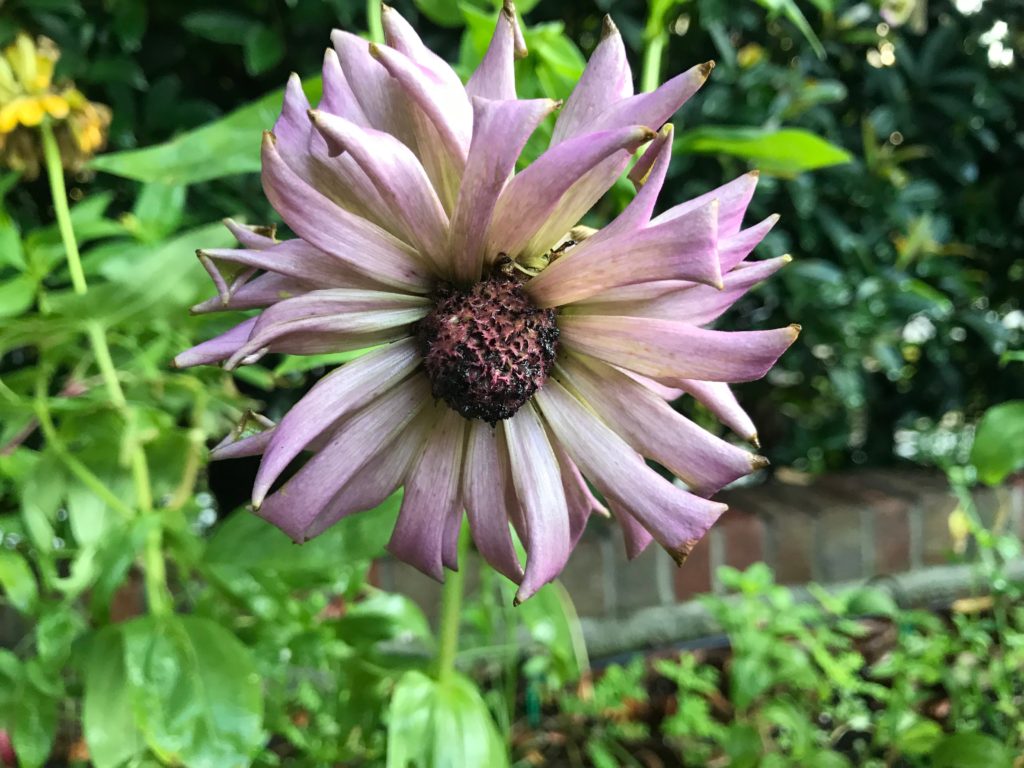
Zinnia in pastel

Hanging out by the pond
Zinnias are a delight in our South Florida garden! They have just given way to the blistering heat of mid-July, but for much of the season, i.e., fall to early summer, you can enjoy their beauty (it is said that they can take the height of our summer heat, but we haven’t seen that). The varieties we grow look like a small version of a sunflower, and they’re beautiful!
Given time during one season, they will form a large shrub, plentiful with blooms. And the colors to choose from are endless, with variety packets available. It’s quite fun to choose zinnia seeds and try them out! The first two flowers above come from Johnny’s Seeds, “Benarys Giant Mix.”
For more information on growing zinnias in South Florida, see UF/IFAS Gardening Solutions: Zinnias
Nasturtiums

NASTURTIUM with a visitor!

2013 – “Year of the Nasturtium”
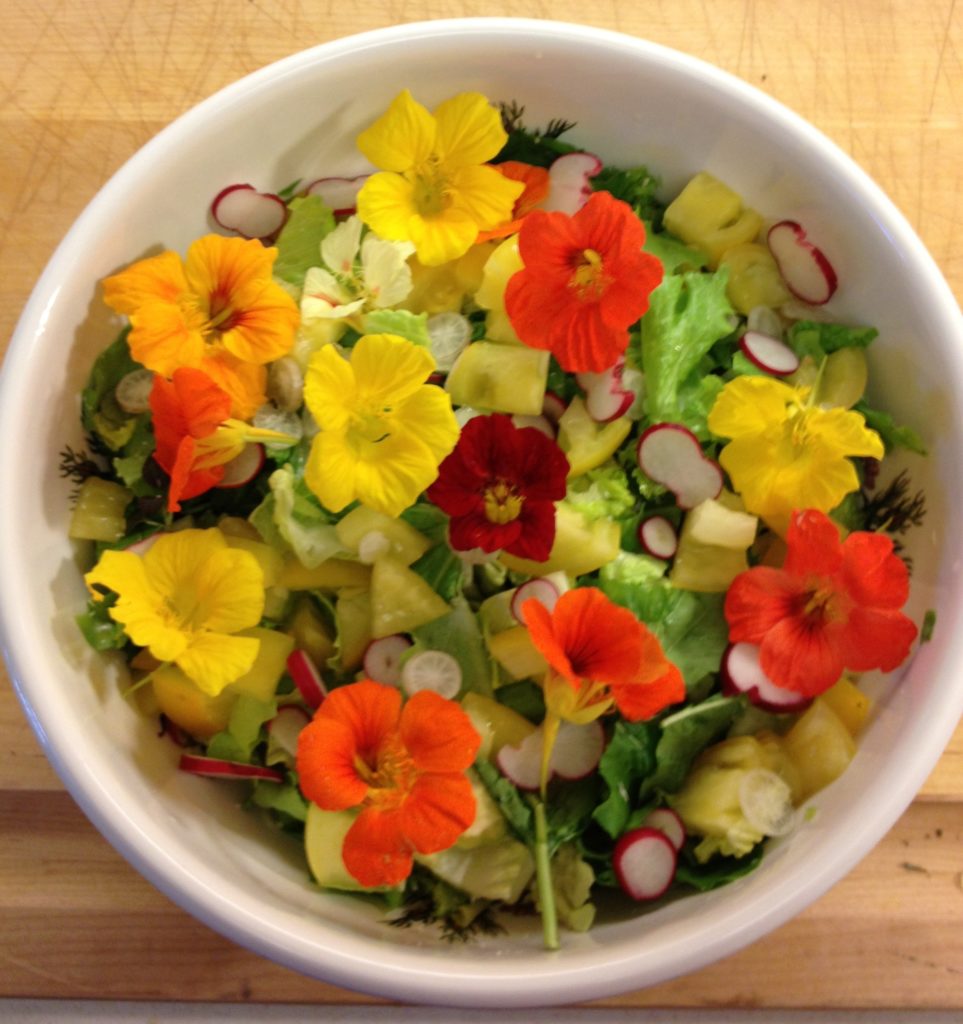
SPRINGTIME SALAD

Nasturtiums going wild!
This is one of our favorite flowers to grow, and by far the most difficult to germinate. We’ve tried various strategies – soaking the seeds, scoring them, clipping the end off of them – and usually to no avail. Several years ago we had the luck of so many seeds sprouting that we had nasturtiums planted all over the garden – what a beautiful sight it was! We dubbed that season “The Year of the Nasturtium.”
Season before last, we finally just bought some nasturtium starter plants (from Tree Amigos Growers in Davie – worth the drive!) and they did well in the garden. Then this past season – voila! – we had volunteers pop up from the previous season which was a nice bonus. We also got about two seeds to sprout! Of course, we will try again this year as we never give up and it’s worth the few bucks of a seed packet to try. Push comes to shove, we’ll buy starters again…
The nasturtium is edible – both flower and leaves! The flower has a spicy taste, and is so wonderful for adorning all kinds of dishes. We love having them on hand when we do our meal events – picking them straight from the garden and using them to beautify our plates is so joyful! At a recent luncheon, one of our members used the leaves to make a nasturtium-basil pesto that topped salmon toasts – yummm! A caution: we did have one person in our garden who had an allergic reaction to eating a nasturtium flower, so please be aware of that if you’ve never tried one.
As you can see above, nasturtiums come in a variety of bright and pastel colors – such a beautiful addition to the garden (and kitchen!) and a friend of those beneficial insects, especially bees! You can learn more facts here: UF/IFAS Gardening Solutions: Nasturtiums
Marigolds
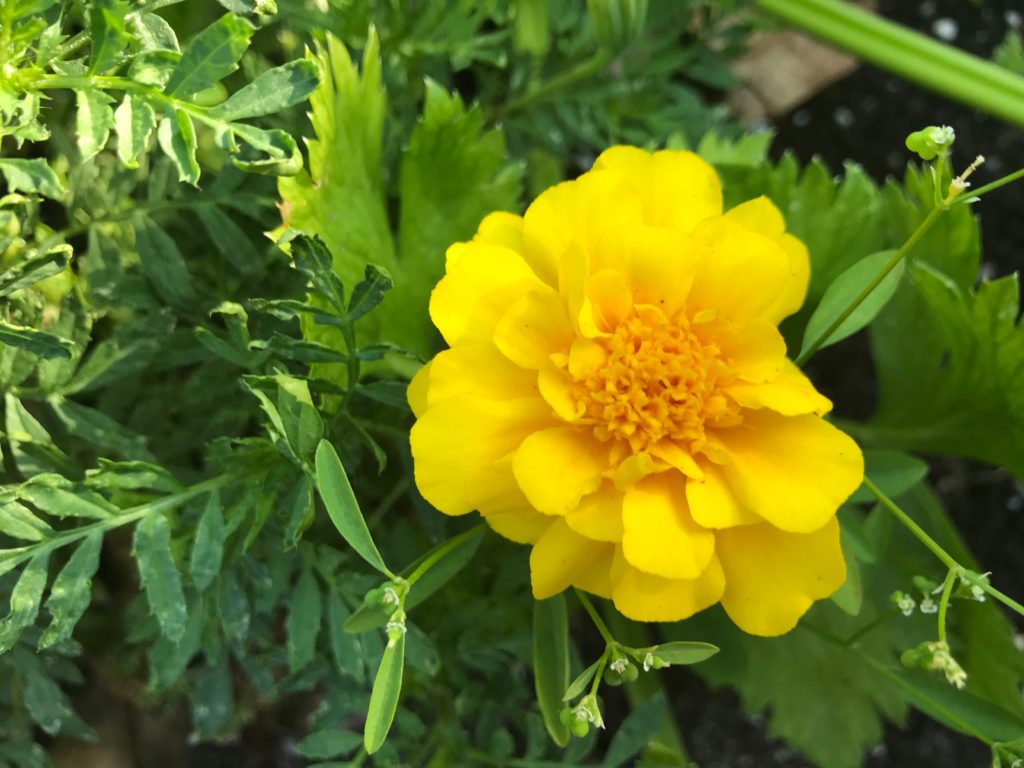
Yellow beauty
The above is from Johnny’s Seeds, “Durango Outback Mix.” (Tagetes patula)

Yellow and orange-yellow variegated marigolds gone wild!
Marigolds are a pretty flower, and so popular that they were once in fierce competition with the rose to become our national flower (the rose won out). They come in a variety of sizes, shapes and colors, and add a great pop of color to any vegetable garden. There are three main species available for seed purchase – it is worth researching each one as they really do vary from each other – the Tagetes patula (aka French), T. tenuifolia (aka Signet), and T. erecta (aka African). We have grown all three varieties in our South Florida garden, and they do very well with practically no care or attention once planted (they prefer dry, well drained and warm soil). We sometimes sow a lot of seeds in one bed and then quite successfully transplant seedlings all around our garden. We do not recommend growing them as densely as the second picture above – that was a failure to thin them out when young.
There are some myths about the benefits of marigolds in a vegetable garden. First, the research just doesn’t bear out that marigolds repel unwanted insects – so even if you have the kind planted that have a strong not-so-pleasant scent (they’ve never bothered us), they are probably not repelling any bad guys! In addition, they will not “kill the nematodes” that certain plants are susceptible to (e.g. tomatoes) by planting them next to each other. For large scale farming, some varieties of marigolds have been shown to suppress nematodes with advance cover crop methods. But for the home vegetable garden, fuggedaboutit!
Now of course you can still plant plant marigolds alongside other plants – they look nice. And according to research, they do attract beneficial insects – namely, hover flies, ladybugs and parasitic wasps. These are good guys that will pollinate or go after some of the bad guys in your garden, so that’s a plus. For an excellent read on the facts about marigolds, please see: Magical Repelling Powers of Marigolds — Myth or Fact?
Calendula

Hello sunshine!
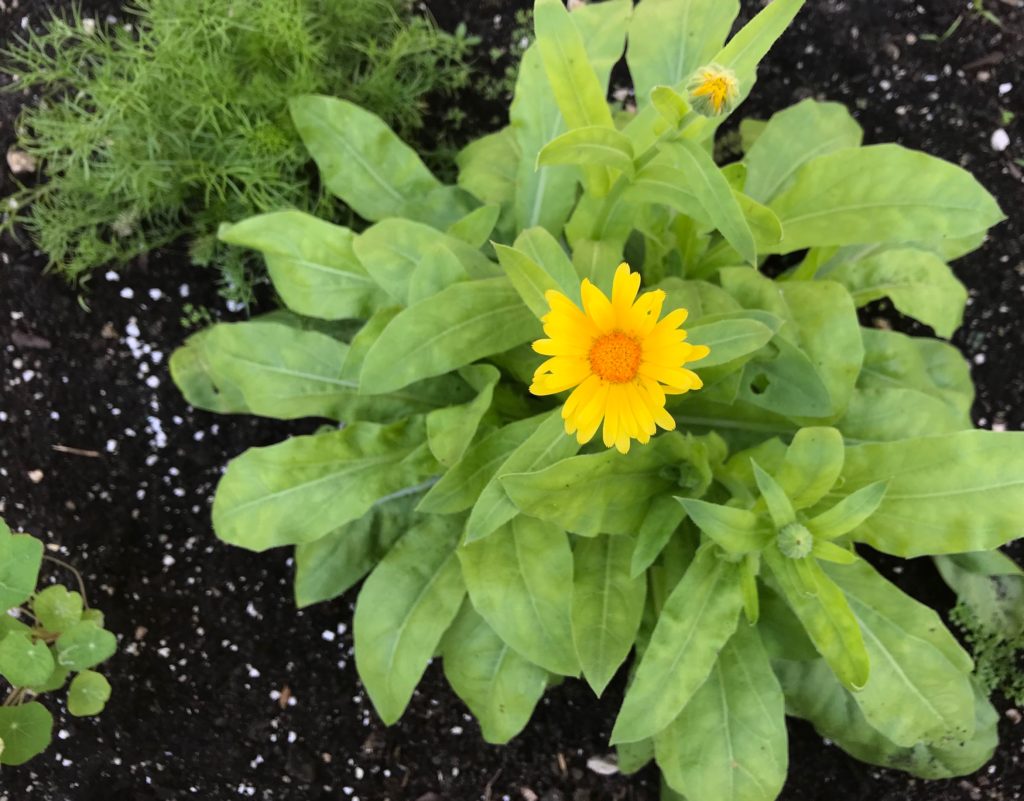
Ready to burst into blooms

This is one plant!

Harvested calendula seeds (not alien life forms!)
Calendula is an easy-to-grow annual that proves to be a strong, enduring and prolific flowering plant when given room to “spread its wings.” Calendula is also known as “pot marigold,” because it is in the same family as marigolds – Asteraceae (aka the daisy family). No wonder calendula looks like a daisy! (But they really do like quite different from a marigold).
While calendula is sometimes used as a decorative yellow or orange annual in flower beds, we love having it in our vegetable garden. It has performed best for us when planted in full sun, and it’s beautiful showcased among the various veggies. Calendula has very strange looking seeds (as you can see above). One of the nice things about this flower is that you will only need to buy seeds once – the seeds are large and very easy to collect each season for planting the next (and possibly a few more seasons after that too!). While some of the seeds will germinate when planted directly in beds, we find they do better when put in starter trays and then transplanted.
Calendula has many benefits. It provides both pollen and nectar to beneficial insects, including bees and butterflies. It also has medicinal qualities that have been widely researched by the medical community. Its most common use is as a salve to treat skin ailments. You can buy creams and ointments, and you can even make your own calendula oil as illustrated in the article cited below. Calendula flowers are also edible, which may or may not be to your liking!
Find out lots of facts about calendula here: Permaculture Plants: Calendula
Fennel Flowers

Fennel flowers
While fennel is not planted just for its flowers, it deserves a place in the lineup here. We grow fennel mainly for the bulbs, which give us that wonderful anise-flavored vegetable to add to salads and all kinds of great dishes (especially appetizers).
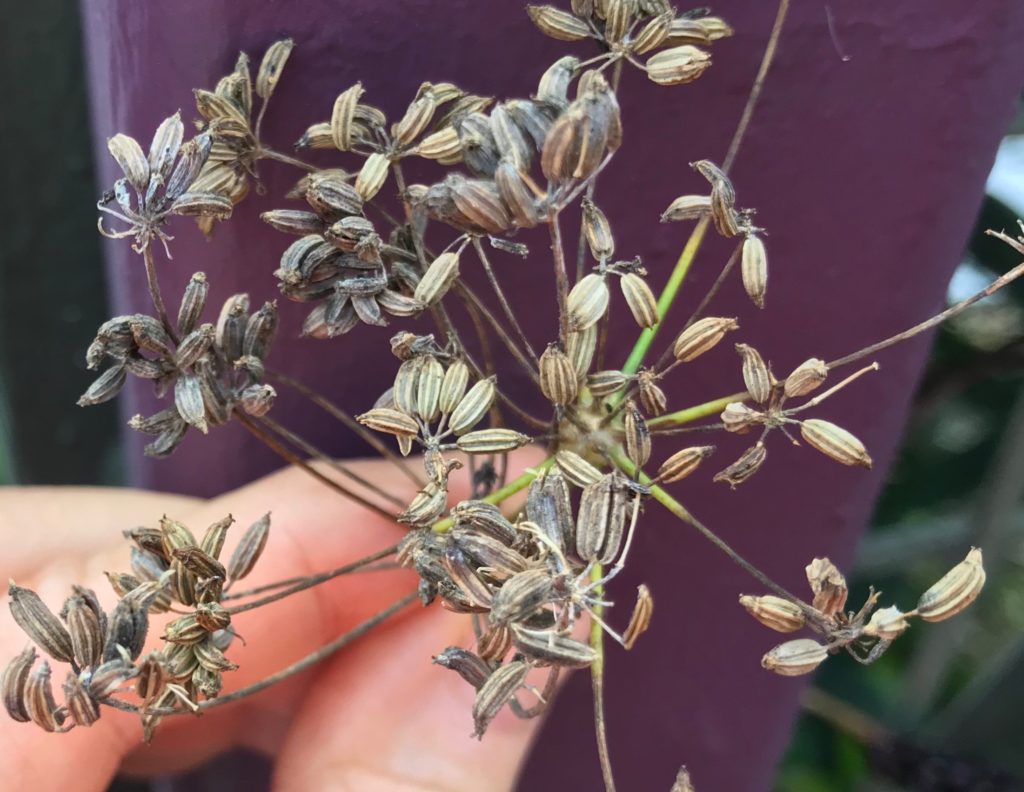
From flower to seed
There are two types of fennel, good to be aware of when you buy seeds: one grown as an herb for the flowers and seeds only (“common” or “wild”), and one as a vegetable (“Florence”) – we grow the latter. After harvesting the majority of our fennel for the bulbs that we use in both raw and cooked dishes, we let a few of the plants remain in the beds and they begin to flower. The flowers are like an herb, adding flavoring to dishes – we especially love sprinkling the pollen onto salads. Fennel pollen has become all the craze the last few years in culinary arts – and if you’ve tasted it, then you know why – it’s just sublime! Of course, we let a significant amount of the flowers dry up on the plant – aka “go to seed.” We harvest and use the seeds to flavor all kinds of dishes, whole or ground up. And they’re so refreshing to munch on, after a meal or any time, really. And of course now you have your own seeds for next year’s planting! It is such a great feeling to use these things that we know we grew and harvested ourselves.
Another wonderful feature: fennel flowers not only attract a variety of beneficial predator insects such as ladybugs, beneficial parasitoid wasps and hoverflies to the garden, they also provide a host for caterpillars of the black swallowtail butterfly. See our latest critter below…

Totally munching out!!
Just a side-note on fennel, we have found through experience that it grows best when planted without any companions. It is the only vegetable that gets its own bed in our garden, and thrives exceptionally well that way. As an aside, this makes for a beautiful display of the flowers in one bed as well.
For more detailed information on fennel plants and their flowers, please read here.
So that is just a sample of the many flowers that can be grown and will benefit a vegetable garden. Of course we will add new varieties this coming season. We have really enjoyed the beauty which the flowers add among our beds, as well as the bees, butterflies and other insects they attract. We hope you are inspired to try growing some of these flowers – it’s easy and so rewarding!

All from the garden!


